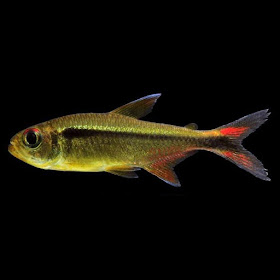 |
| Hyphessobrycon chiribiquete
García‐Alzate, Lima, Taphorn, Mojica, Urbano‐Bonilla & Teixeira, 2020
DOI: 10.1111/jfb.14319
|
ABSTRACT
Hyphessobrycon chiribiquete n. sp. is described from the Río Caquetá drainage in Colombia and the Río Ucayali drainage in Peru, western Amazon. The new species is diagnosed from its congeners by having the following combination of characters: a conspicuous narrow midlateral stripe, starting on sides of body behind the opercle near the lateral line; lateral stripe overlapped anteriorly with a vertically elongated humeral blotch; inner premaxillary teeth pentacuspid; margin of anal fin falcate in mature males, with a relatively well‐developed anterior lobe.
Keywords: Río Caquetá drainage, Río Ucayali drainage, Serrania de Chiribiquete, Hyphessobrycon agulha, Neotropical diversity
 |
| Live colors of Hyphessobrycon chiribiquete. ICN-MHN 21764, paratype, 28.3 mm Ls. Female. |
Hyphessobrycon chiribiquete new species
Etymology: The specific epithet refers to the type locality of this species, in the Parque Nacional Natural Serranía de Chiribiquete, and territory of the ancient indigenous Carijonas. It is to be treated as a noun in apposition. Chiribiquete National Natural Park is located in the northwest sector of the Colombian Amazon in the departments of Caquetá and Guaviare. The nearest large town is San Juan de Guaviare. It is the largest national park in Colombia and the largest tropical rainforest national park in the world. It was established on 21 September 1989 and has been expanded twice, first in August 2013 and then in July 2018. The park occupies about 43,000 km2 (17,000 sq mi) and includes the Serranía de Chiribiquete highlands and surrounding lowlands, which are covered by rainforest and savannas. (WWF 2018, Website of Parques Naturales Nacionales de Colombia 2019).
C. A. García‐Alzate, F. C. T. Lima, D. C. Taphorn, J. I. Mojica, A. Urbano‐Bonilla and T. F. Teixeira. 2020. A New Species of Hyphessobrycon Durbin (Characiformes: Characidae) from the western Amazon basin in Colombia and Peru. Journal of Fish Biology. DOI: 10.1111/jfb.14319
